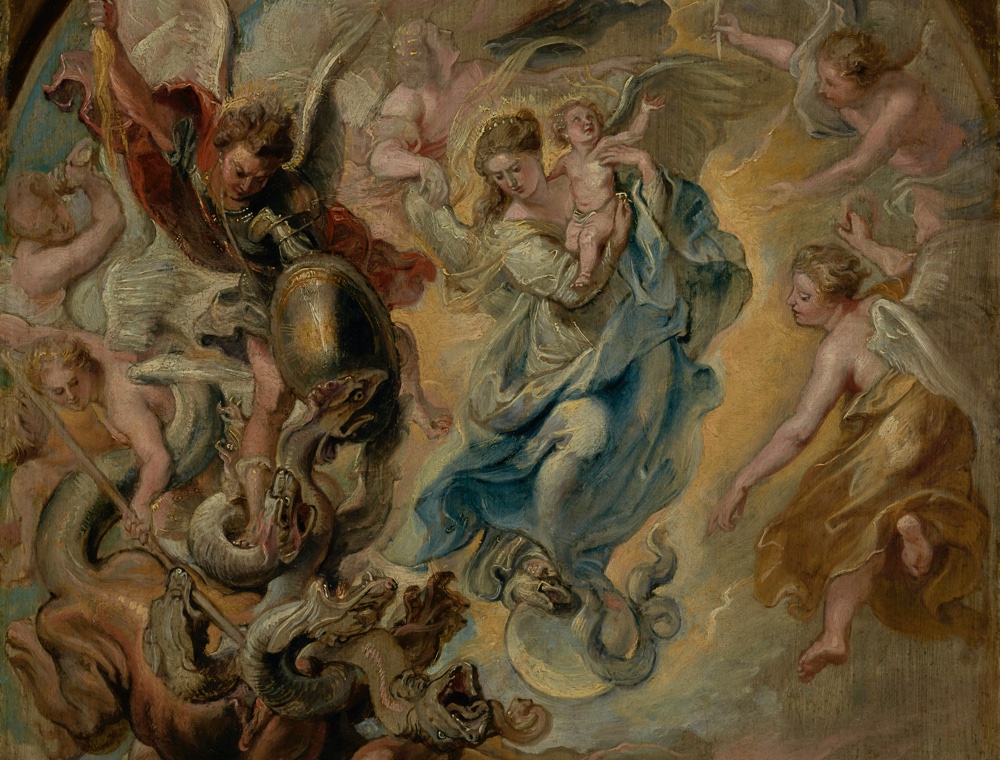
Peter Paul Rubens (Flemish, 1577 - 1640)
The Virgin as the Woman of the Apocalypse, about 1623–1624, Oil on panel
64.5 × 49.8 cm (25 3/8 × 19 5/8 in.), 85.PB.146
The J. Paul Getty Museum, Los Angeles
Revelation 12:1–5. Now a great sign appeared in heaven: a woman clothed with the sun, with the moon under her feet, and on her head a garland of twelve stars. Then being with child, she cried out in labor and in pain to give birth. […] And the dragon stood before the woman who was ready to give birth, to devour her Child as soon as it was born. She bore a male Child who was to rule all nations with a rod of iron. And her Child was caught up to God and His throne.
Before we try to identify the male child we must first identify the woman. In this short article we’ll just jump straight to the conclusion, but we go into much more depth on this topic in Delivered From Delusion.
The woman being “clothed with the sun, with the moon under her feet, and on her head a garland of twelve stars” is undoubtedly a reference by the author to the nation of Israel, as Joseph (the son of Jacob/Israel) had a dream in which his father, mother and brothers were the “the sun, the moon, and the eleven stars” (Genesis 37:9), with Joseph himself being the twelfth star, of course. There is no other Old Testament typology to which this could be referring.
Isaiah also points to the same conclusion:
Isaiah 66:7–10. “Before she was in labor, she gave birth; before her pain came, she delivered a male child. […] For as soon as Zion was in labor, she gave birth to her children. […] Rejoice with Jerusalem, and be glad with her, all you who love her; […]”
There is, however, one substantial difference between the passage in Isaiah and the one in Revelation, and that is that in Isaiah the woman gave birth before labouring, whereas in Revelation 12 she gives birth after labouring. In both passages the woman is the same, but the birth is not!
There are two scripturally plausible possibilities for who the male child is, based on the fact that he is said to “rule all nations with a rod of iron”. The first possibility is that it is Yeshua:
Revelation 19:15. Now out of His mouth goes a sharp sword, that with it He should strike the nations. And He Himself will rule them with a rod of iron. […]
However, the male child in Isaiah 66:7 is Yeshua. He was born before Jerusalem travailed, and her travail did not start until after His death. This is a fundamental difference from the birth of the male child in Revelation 12 which suggests Revelation 12 is not speaking of Yeshua. Other differences are that in Revelation 12 the dragon was waiting to devour the child as soon as it was born, whereas that occurred sometime later in the account of the birth of Yeshua in Matthew 2; and in Revelation 12 the woman flees after the child is caught up, whereas in Matthew the woman fled with the child. And perhaps most importantly, in Revelation 4:1 John is told he will be shown “things which must take place after this”—which means that Revelation as a whole is looking forward, not back—whereas the birth of Yeshua had already taken place by that point in time.
Fortunately there is another possibility for the identity of the male child, which can be found in Revelation 2:
Revelation 2:26–27. And he who overcomes, and keeps My works until the end, to him I will give power over the nations— ‘He shall rule them [the nations] with a rod of iron; they shall be dashed to pieces like the potter’s vessels’— as I also have received from My Father;
Thus, the male child being referred to in Revelation 12 must be the overcomers within the church that Yeshua spoke of in His letters, the ones to whom He promised special rewards—one of which was to rule the nations with a rod of iron with Himself.
Paul substantiates this interpretation in Galatians 4:26 where he says “the Jerusalem above […] is the mother of us all”, likening Jerusalem (in a spiritual sense) to a mother, and the church to her children. We also know her children are the church as Revelation 12:17 says the rest of her (the woman’s) offspring are those “who keep the commandments of God and have the testimony of Jesus Christ.”
It is apparent that the overcomers in the letters to the seven churches do not include everyone from within those churches. In a similar manner the male child is only one of the woman’s (many) children. We’ll discuss this distinction between the male child and the rest of the woman’s children in the next two articles in this series.
Up Next: Who is the Bride?
Back To: Who is the Restrainer?
You might also be interested in these series: